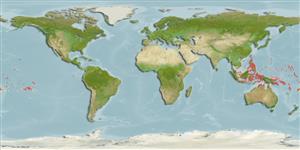Malacostraca |
Decapoda |
Alpheidae
Environment: milieu / climate zone / depth range / distribution range
Ecology
Benthic; depth range 0 - 1 m (Ref. 81110). Tropical
Central Pacific.
Length at first maturity / Size / Weight / Age
Maturity: Lm ? range ? - ? cm Max length : 4.47 cm TL (female)
Found in burrows of large callianassid ghost shrimps (i.e., Neocallichirus calmani and Glypturus cf. armatus) on intertidal and shallow subtidal sand flats fringed by mangroves (Ref. 81110).
Life cycle and mating behavior
Maturity | Reproduction | Spawning | Eggs | Fecundity | Larvae
Members of the order Decapoda are mostly gonochoric. Mating behavior: Precopulatory courtship ritual is common (through olfactory and tactile cues); usually indirect sperm transfer.
Anker, A. and I.N. Marin 2009 The alpheid shrimp genus Leptalpheus Williams, 1965, in the tropical Western Pacific, with descriptions of two new species (Crustacea: Decapoda: Caridea). The Raffles Bulletin of Zoology 57(1):91-107. (Ref. 81110)
IUCN Red List Status
(Ref. 130435: Version 2025-1)
CITES status (Ref. 108899)
Not Evaluated
Not Evaluated
Threat to humans
Harmless
Human uses
| FishSource |
Tools
More information
Trophic EcologyFood items (preys)
Diet composition
Food consumption
Predators
Population dynamicsGrowthMax. ages / sizesLength-weight rel.Length-length rel.Length-frequenciesMass conversionAbundance Life cycleReproductionMaturityFecunditySpawningEggsEgg developmentLarvae PhysiologyOxygen consumption
Human RelatedStamps, coins, misc.
Internet sources
Estimates based on models
Preferred temperature
(Ref.
115969): 27.4 - 29.3, mean 28.7 (based on 1155 cells).
Fishing Vulnerability
Low vulnerability (10 of 100).
